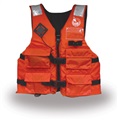River Running - and More!
Reprinted from December 1987
by Leonard Hulsebosch
Introduction
The newsletter section of this web site contains 40 years of Houston Canoe Club newsletters. Amidst those many publications are buried a lot of gems of wisdom, that are still just as valid today as when they first appeared. The following article from 30-years ago is one of those gems.
Your P.F.D.
Skill levels in running rivers is useless to the boater unless he makes sure, prior to his run, that his equipment is complete and ready for the job ahead.
Stores that sell quality river equipment are few. You can find them through advertising in club newsletters and word-of-mouth. Some dealers also act as repair centers for damaged equipment. Find these dealers by local boater inquiry. Most dealers are helpful and even give lengthly explanations of various types of equipment to help you understand and make the proper selections.
 Let's start with one of the most important pieces of equipment - your P.F.D. or life jacket. The most important consideration to remember is that no P.F.D. suited for river running is tested by the Coast Guard or the manufacturer in moving water. By definition, a Type V P.F.D. will right an unconscious person and keep the wearer in a 45 degree head-back position. In reality, it will not because of the action of moving water. The only two P.F.D's river runners should consider are Type III and V.
Let's start with one of the most important pieces of equipment - your P.F.D. or life jacket. The most important consideration to remember is that no P.F.D. suited for river running is tested by the Coast Guard or the manufacturer in moving water. By definition, a Type V P.F.D. will right an unconscious person and keep the wearer in a 45 degree head-back position. In reality, it will not because of the action of moving water. The only two P.F.D's river runners should consider are Type III and V.
Type III's have a minimum of 15-1/2 pounds of flotation and are designed to place a person in a vertical or slightly backward position. Flotation is provided by a closed cell foam which will remain buoyant even if punctured. These life jackets are, by far, the most comfortable, and they are the preference of most kayakers, canoeists and rafters. They have a zippered front closure, elastic bottoms, and waist belt. Type III P.F.D.'s are the most popular type available.
Type V is required to have 22 pounds of floatation for adults, and 11 pounds for children. Floatation is provided by a high density closed cell foam that will not absorb water when punctured. This P.F.D. is ideally suited for rafters, but kayakers and canoeists find it too bulky.
A P.F.D. is no good If it comes off. Make sure yours is snug-fitting around the chest and cannot be pulled off over the head. Some river runners customize their p.f.d.'s by running two straps from
front to back, under the crotch, attached by quick release buckles. This prevents the P.F.D. from rising up and jamming under your chin and armpits, and even being flushed off your body over your head when stressed by a "wet exit" in turbulent water. A P.F.D. is no good if it comes off.
If you should accidentally swim down a river, swim with a side stroke or better yet, with a backstroke - body horizontal to the surface of the water and feet downstream. It is absolutely best to employ the latter self rescue technique.
Should turbulence push you underwater, do not reach up for the surface. Probability is your P.F.D. will slip off over your head unless you have customized straps on your P.F.D. Rivers do not "suck" people under and hold them, after being "maytagged" or tumbled, you will float back up toward the surface - but in the meantime, your own panic may interfere! The way to avoid such panic is to convince yourself beforehand that you will float up and you will get to the shore. How? By swimming and floating through several rapids as a personal self-rescue training course.
Do not ever confuse river P.F.D.'s with those made for one-time use on ships, which contain plastic bags filled with a bulky fiber core "kapok". When this type is used on the river, the plastic bags develop leaks, the kapok absorbs the water, thus turning your life jacket into a "death" jacket. Also, avoid "horse-collar" P.F.D's which contain too little floatation in the the front and none in the back.
Remember, P.F.D's contain tender foam, so be careful with them. They should not be sat on or have any other abuse that will compress the foam. At home, you should also hang them up so that they will dry and re-expand. ·
It goes without saying that P.F.D's should be worn on the river at all times. A P.F.D. serves no purpose tied to a thwart. It is designed to increase your chances of survival in an emergency. It is your best friend in need - but it only works if you use it!
 |
| The author, Leonard Hulsebosch |